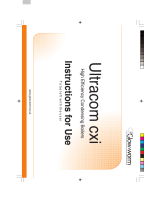
17
221834B
Diagram 7.1.A
FAN
BRACKET
FAN BRACKET
SECURING SCREW (2)
FAN SECURING
SCREW (3)
4444
7 Flue Installation
7.1 Rear Flue
Mark and cut the air duct terminal assembly, see diagram 7.1
and the flue duct, diagram 7.2 to the lengths required, cutting
square and removing any burrs.
Refer to diagram 7.3, mark through the holes in the flue elbow
assembly and drill the duct as shown, making sure of the correct
alignment of the “Top”.
7.2 Side Flue
Mark and cut the air duct terminal assembly, see diagram 7.4
and flue duct, diagram 7.5 to the lengths required, cutting
square and removing any burrs.
Refer to diagram 7.3 mark through the holes in the flue elbow
assembly and drill the flue duct as shown, making sure of the
correct alignment of the “Top”.
7.3 Internal Flue Assembly
If access to the outside wall is not practical, the flue system can
be installed from inside. Use of the optional wall liner kit
recommended.
Apply sealant to the flue duct, locate into the air duct terminal,
see diagram 7.6.
Apply sealant to the flue elbow spigot and then locate the flue
and air duct terminal assembly to the flue elbow as shown in
diagram 7.3, making sure of the alignment of the “Top”.
Secure the air duct/terminal assembly to the flue elbow and flue
duct assembly with the two self tapping screws supplied in the
loose items pack and then seal with the tape provided.
Place the flue assembly into the flue hole. Make sure that the
flue terminal is correctly positioned and projecting the correct
distance from the outside wall face, see diagram 7.9.
7.4 External Flue Installation
Locate the air duct/terminal assembly into the flue elbow
assembly as shown in diagram 7.3, making sure of correct
terminal alignment of the “TOP”.
Mark the position of the air duct terminal assembly securing
holes and drill two 2.8mm diameter holes through the air duct/
terminal assembly.
Apply sealant to the flue duct and locate into air duct terminal,
see diagram 7.6.
From outside, place the air duct/terminal assembly and flue
duct into the flue hole. Make sure that the flue terminal is
correctly positioned and projecting the correct distance from
the outside wall face, see diagram 7.9.
Apply sealant to the flue elbow spigot and then locate the flue
and air duct terminal assembly as shown in diagram 7.3, make
sure of the correct alignment of the “Top”.
Secure the air duct terminal to the flue elbow with the two self
tapping screws supplied in the loose items pack, then seal with
the tape provided.
7.5 Flue Elbow
Fit the flue elbow gasket, from the fittings pack, to the casing
top.
The two fan bracket securing screws should be loosened, but
not removed, before slackening the three fan securing screws.
After locating the flue elbow into the outlet of the fan, secure the
flue elbow onto the top panel with the four M4x14 screws
provided.
Then push fan upward, making sure that the flue elbow spigot
engages inside the fan outlet and compresses the gasket.
Diagram 7.1
"Q"
STANDARD FLUE
TERMINAL
LONG FLUE
TERMINAL
"Q" plus 67mm
6862
Complete assembly by fully tightening the two fan bracket
securing screws.
Finally tighten the three fan securing screws.
Fit the inner case door.




















